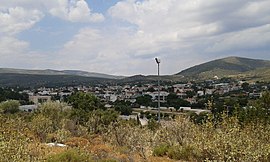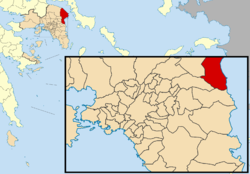| Marathon Μαραθώνας | |
|---|---|
| Municipality | |
 The town of Marathon The town of Marathon | |
  | |
| Coordinates: 38°9′N 23°57′E / 38.150°N 23.950°E / 38.150; 23.950 | |
| Country | Greece |
| Administrative region | Attica |
| Regional unit | East Attica |
| Government | |
| • Mayor | Stergios Tsirkas (since 2019) |
| Area | |
| • Municipality | 222.75 km (86.00 sq mi) |
| • Municipal unit | 97.06 km (37.48 sq mi) |
| Elevation | 33 m (108 ft) |
| Population | |
| • Municipality | 31,331 |
| • Density | 140/km (360/sq mi) |
| • Municipal unit | 10,063 |
| • Municipal unit density | 100/km (270/sq mi) |
| Time zone | UTC+2 (EET) |
| • Summer (DST) | UTC+3 (EEST) |
| Postal code | 190 07 |
| Area code(s) | 22940 |
| Vehicle registration | Z |
| Website | www.marathon.gr |
Marathon (Demotic Greek: Μαραθώνας, Marathónas; Attic/Katharevousa: Μαραθών, Marathṓn) is a town in Greece and the site of the Battle of Marathon in 490 BCE, in which the heavily outnumbered Athenian army defeated the Persians. Legend has it that Pheidippides, a Greek herald at the battle, was sent running from Marathon to Athens to announce the victory, which is how the marathon running race was conceived in modern times. Today it is part of East Attica regional unit, in the outskirts of Athens and a popular resort town and center of agriculture.
History

The name "Marathon" (Μαραθών) comes from the herb fennel, called márathon (μάραθον) or márathos (μάραθος) in Ancient Greek, so Marathon literally means "a place full of fennel". It is believed that the town was originally named so because of an abundance of fennel plants in the area.
In ancient times, Marathon (Ancient Greek: Μαραθών) occupied a small plain in the northeast of ancient Attica, which contained four places, Marathon, Probalinthus, Tricorythus, and Oenoe, which originally formed the Tetrapolis, one of the 12 districts into which Attica was divided before the time of Theseus. Here Xuthus, who married the daughter of Erechtheus, is said to have reigned; and here the Heracleidae took refuge when driven out of Peloponnesus, and defeated Eurystheus. The Marathonii claimed to be the first people in Greece who paid divine honours to Heracles, who possessed a sanctuary in the plain. Marathon is also celebrated in the legends of Theseus, who conquered the ferocious bull, which used to devastate the plain. Marathon is mentioned in Homer's Odyssey in a way that implies that it was then a place of importance. In mythology, its name was derived from an eponymous hero Marathon, who is described by Pausanias as a son of Epopeus, king of Sicyon, who fled into Attica in consequence of the cruelty of his father Plutarch calls him an Arcadian, who accompanied the Dioscuri in their expedition into Attica, and voluntarily devoted himself to death before the battle.
After Theseus united the 12 independent districts of Attica into one state, the name of Tetrapolis gradually fell into disuse; and the four places of which it consisted became Attic demi, Marathon, Tricorythus, and Oenoë belonging to the tribe Aeantis, and Probalinthus to the tribe Pandionis; but Marathon was so superior to the other three, that its name was applied to the whole district down to the latest times. Hence Lucian speaks of "the parts of Marathon about Oenoë".
Few places have obtained such celebrity in the history of the world as Marathon, on account of the victory which the Athenians here gained over the Persians in 490 BCE (Battle of Marathon). After Miltiades (the general of the Greek forces) defeated Darius' Persian forces, the Persians decided to sail from Marathon to Athens in order to sack the unprotected city. Miltiades ordered all his hoplite forces to march "double time" back to Athens, so that by the time Darius' troops arrived they saw the same Greek force waiting for them.
Although the name Marathon had a positive resonance in Europe in the nineteenth century, for some time that was sullied by the Dilessi murders, which happened nearby in 1870.
In the 19th century and beginning of twentieth century the village was inhabited by an Arvanite population.


The sophist and magnate Herodes Atticus was born in Marathon. In 1926, the American company ULEN began construction on the Marathon Dam in a valley above Marathon, in order to ensure water supply for Athens. It was completed in 1929. About 10 km of forested land were flooded to form Lake Marathon.

The beach of Schinias is located southeast of the town. The beach is popular as a spot for windsurfing and the Olympic Rowing Center used for the 2004 Summer Olympics is also located there.
At the 1896 and 2004 Summer Olympics, Marathon was the starting point of the marathon races (for both women and men in 2004). Marathon is also the starting point for the annual Athens Classic Marathon.
The area is susceptible to flash flooding, because of forest fires having denuded parts of the eastern slopes of Mount Penteli especially in 2006.
Municipality
The municipality Marathon was formed at the 2011 local government reform by the merger of the following 4 former municipalities, that became municipal units:
- Grammatiko
- Marathon
- Nea Makri
- Varnavas
The municipality has an area of 222.747 km, the municipal unit 97.062 km.
Population
| Year | Town | Municipal unit | Municipality |
|---|---|---|---|
| 1981 | 4,841 | - | - |
| 1991 | 5,453 | 12,979 | - |
| 2001 | 4,399 | 8,882 | - |
| 2011 | 7,170 | 12,849 | 33,423 |
| 2021 | 5,260 | 10,063 | 31,331 |
The other settlements in the municipal unit are Agios Panteleimonas, Kato Souli, Vranas, Avra, Vothon, Ano Souli and Schinias.
Points of interest

- The Soros, a tumulus (Greek Τύμβος, tymbos, tomb), or burial mound, erected to the 192 Athenian fallen at the Battle of Marathon, is a feature of the coastal plain, now marked by a marble memorial stele and surrounded by a small park.
- Kato Souli Naval Transmission Facility with its 250-metre (820 ft) tall radio mast, the tallest structure in Greece.
Sister cities
 Hopkinton, Massachusetts, United States
Hopkinton, Massachusetts, United States Xiamen, China
Xiamen, China
See also
- List of municipalities of Attica
- List of settlements in Attica
- Dimitrion Yordanidis, oldest man to have run the marathon, at age 98
Notes and references
- Notes
- In modern Greek the sports event is called Marathonios Dromos (Μαραθώνιος Δρόμος) or simply Marathonios.
- The Greek word for fennel is first attested in Mycenaean Linear B on tablets MY Ge 602, MY Ge 606 + fr., MY Ge 605 + 607 + frr. + 60Sa + 605b - as 𐀔𐀨𐀶𐀺, ma-ra-tu-wo.
- References
- Municipality of Marathon, Municipal elections – October 2023, Ministry of Interior
- "Αποτελέσματα Απογραφής Πληθυσμού - Κατοικιών 2021, Μόνιμος Πληθυσμός κατά οικισμό" [Results of the 2021 Population - Housing Census, Permanent population by settlement] (in Greek). Hellenic Statistical Authority. 29 March 2024.
- μάραθον. Liddell, Henry George; Scott, Robert; A Greek–English Lexicon at the Perseus Project.
- "The Linear B word ma-ra-tu-wo". Palaeolexicon. Word study tool of Ancient languages. Raymoure, K.A. "ma-ra-tu-wo". Minoan Linear A & Mycenaean Linear B. Deaditerranean. Archived from the original on 2019-07-05. Retrieved 2014-03-19. "MY 602 Ge (57)". "MY 606 Ge + fr. (57)". "MY 605 Ge + 607 + fr. [+] 60Sa + fr. [+] 605b + frr. (57)". DĀMOS: Database of Mycenaean at Oslo. University of Oslo.
- Μαραθών in Liddell and Scott.
- Strabo. Geographica. Vol. viii. p.383. Page numbers refer to those of Isaac Casaubon's edition.
- Stephanus of Byzantium. Ethnica. Vol. sub voce Τετμάπολις.
- Pausanias (1918). "15.3". Description of Greece. Vol. 1. Translated by W. H. S. Jones; H. A. Ormerod. Cambridge, Massachusetts; London: Harvard University Press; William Heinemann – via Perseus Digital Library., 1.35.4.
- Plutarch, Thes. 14; Strabo. Geographica. Vol. ix. p. 399. Page numbers refer to those of Isaac Casaubon's edition.
- Pausanias (1918). "27.10". Description of Greece. Vol. 1. Translated by W. H. S. Jones; H. A. Ormerod. Cambridge, Massachusetts; London: Harvard University Press; William Heinemann – via Perseus Digital Library.
- Homer. Odyssey. Vol. 7.80.
- Pausanias (1918). "1.1". Description of Greece. Vol. 2. Translated by W. H. S. Jones; H. A. Ormerod. Cambridge, Massachusetts; London: Harvard University Press; William Heinemann – via Perseus Digital Library., 2.6.5, 1.15.3, 1.32.4
- Plutarch, Thes. 32.
- Μαραθῶνος τὰ περὶ τὴν Οἰνόην, Icaro-Menip. 18.
- Chase, Thomas, Hellas, her monuments and scenery, Sever and Francis, Cambridge, pp. 102–103
- Hichens, The Near East, Dalmatia, Greece and Constantiople, Hodder and Stoght, London, 1913, p. 116.
- Wallechinsky, David and Jaime Loucky (2008). "Track & Field (Men): Marathon". In The Complete Book of the Olympics: 2008 Edition. London: Aurum Press Limited. p. 133.
- 2004 Summer Olympics official report. Archived 2008-08-19 at the Wayback Machine Volume 2. p. 242.
- "ΦΕΚ B 1292/2010, Kallikratis reform municipalities" (in Greek). Government Gazette.
- "Population & housing census 2001 (incl. area and average elevation)" (PDF) (in Greek). National Statistical Service of Greece. Archived from the original (PDF) on 2015-09-21.
- Aerial photograph in John Boardman, Jasper Griffin and Oswyn Murray, Greece and the Hellenistic World (Oxford History of the Classical World) 1988, vol. I p. 34.
Attribution
![]() This article incorporates text from a publication now in the public domain: Smith, William, ed. (1854–1857). "Marathon". Dictionary of Greek and Roman Geography. London: John Murray.
This article incorporates text from a publication now in the public domain: Smith, William, ed. (1854–1857). "Marathon". Dictionary of Greek and Roman Geography. London: John Murray.
Bibliography
- Δεκουλάκου, Ιφιγένεια (2021). "Ανασκαφή στο ιερό των Αιγυπτίων θεών τον Μαραθώνα". Πρακτικά Αρχαιολογικής Εταιρείας. 176: 19–32.
External links
- Official web site (in Greek)
- www.e-marathon.gr (in Greek)
| Places adjacent to Marathon, Greece | ||||||||||||||||
|---|---|---|---|---|---|---|---|---|---|---|---|---|---|---|---|---|
| ||||||||||||||||
| Administrative divisions of the Attica Region | ||
|---|---|---|
| Regional unit of Central Athens |  | |
| Regional unit of North Athens | ||
| Regional unit of West Athens | ||
| Regional unit of South Athens | ||
| Regional unit of Piraeus | ||
| Regional unit of East Attica | ||
| Regional unit of West Attica | ||
| Regional unit of Islands | ||
| ||
| Subdivisions of the municipality of Marathon | |
|---|---|
| Municipal units | |
 | ||
- Marathon, Greece
- Venues of the 1896 Summer Olympics
- Venues of the 2004 Summer Olympics
- Olympic athletics venues
- Olympic cycling venues
- Cities in ancient Attica
- Populated places in East Attica
- Battle of Marathon
- Demoi
- Ancient Greek cities
- Populated places in ancient Attica
- Locations in Greek mythology
- Arvanite settlements

